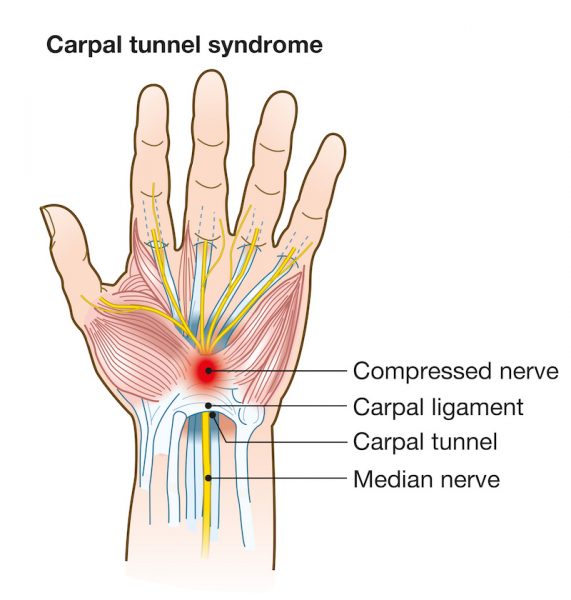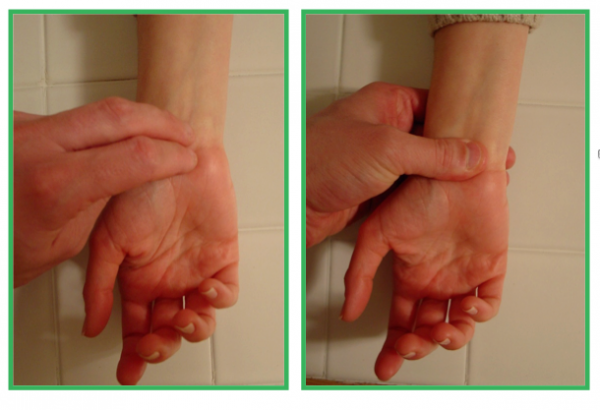
Carpal tunnel syndrome happens when there is too much pressure on an important nerve in your wrist. When you understand how the wrist is designed, you’ll see why it can happen.
The carpal tunnel is narrow — only about an inch wide – and pretty rigid. The bottom and sides are formed by the tiny bones in the wrist and the top is covered by a band of connective tissue called the transverse carpal ligament.
Nine tendons that are responsible for bending our fingers and thumb travel through the carpal tunnel. So does the median nerve, one of the main nerves in the hand gives us feeling in the thumb and index, middle and ring fingers. It also controls the muscles around the base of the thumb.
Carpal tunnel risk factors
There are several risk factors that can lead to carpal tunnel syndrome:
- Gender
- Women are at greater risk because the tunnel tends to be smaller.
- Age
- Risk increases with age generally because of wear and tear.
- Pregnancy
- Carpal tunnel is very common during pregnancy, usually during the third trimester. That’s because a lot of fluid shifts and it can pool in and around the wrists.
- Diabetes
- Diabetes often affects blood vessels. If blood sugars are elevated for a prolonged period, artery walls become thicker and there can be less blood flow to the hands. The result is it takes even less pressure than normal to cause symptoms of carpal tunnel syndrome.
- Rheumatoid arthritis
- Rheumatoid arthritis, gout, and other inflammatory conditions cause increased swelling around tendons which can increase the pressure on the tunnel and cut off the blood supply to the nerve.
- Occupational hazards
- repetitive gripping
- repetitive pinching
- extreme postures of the wrist — back or forward — that can narrow the carpal tunnel
- vibration — nerves do not usually like vibration

But risk factors may not always play a role says Dr. Lauren Adey, an orthopaedic surgeon at Central Maine Orthopaedics in Auburn, Maine.
Although there are risk factors for carpal tunnel not everyone has a specific reason why this develops. It often just happens.
Lauren Adey, MD, Central Maine Orthopaedics
Signs and symptoms
These are the most common symptoms:
- Numbness/tingling/burning in hand — not the whole hand but in the thumb, index, middle finger and half of the ring finger.
- An ache that travels up the forearm, even into the shoulder.
- Decreased sensation.
- You keep dropping things because you have decreased sensation.
- Trouble pinching, picking up tiny objects.
- Weakness
- Atrophy of muscle around the thumb.
- Dry skin. The median nerve controls sweat glands. The more advanced the carpal tunnel, the dryer the skin in the hand.

How carpal tunnel is diagnosed
Two tests are commonly done:
Tinel test Tap on the nerve that sits right at the base of the wrist under the surface of the skin. The tapping irritates the nerve. If it’s damaged you’ll feel a zing along the course of the nerve into the finger. The Tinel test is usually most useful in the early stages of carpal tunnel.
Compression test Put pressure on the wrist and hold for 30 to 60 seconds. Ths extra pressure on the nerve will quickly cause buzzing and tingling in the hand.
Additional tests for sensation, muscle and motor strength may also be done. And an x-ray might be ordered to rule out other conditions that can mimic carpal tunnel, such as arthritis.
Treating carpal tunnel syndrome
Treatment depends on how much of a problem you have. Symptoms can wax and wane, but once it starts, it usually worsens slowly over time.
In the beginning, if you still have normal sensation and normal strength, ergonomic modifications are usually recommended.
- Avoid gripping
- Avoid repetitive pinching
- Avoid extreme hand positions. Keep your wrist neutral
- Try wearing wrist splints at night
If you have a flare-up, you can try taking an anti-inflammatory drug, but only for three to five days.
Cortisone injections may work in the short-term if you have mild symptoms. They help by decreasing swelling in carpal tendons, which takes the pressure off the nerve. The only problem is it eventually wears off.
Physical therapy can also provide some short-term relief.
If you have numbness or weakness or you’ve tried everything else and still have symptoms, the next step is usually surgery to release the transverse carpal ligament.
“Carpal tunnel surgery is one of the most commonly performed procedures in the US and also one of the most effective. “
Dr. Adey
Can you prevent carpal tunnel syndrome?
I won’t promise you’ll never develop carpal tunnel syndrome, but an ounce of prevention might be worth a pound of cure. It certainly wouldn’t hurt if you followed some of these tips:
- Relax your grip
- Gently stretch and flex your hands and wrists every so often
- Take frequent breaks, especially if you use vibrating equipment
- If you use a computer, keep your hand in as neutral a position as possible
For more information about carpal tunnel syndrome visit the American Association of Orthopaedic Surgeons.

Leave A Comment